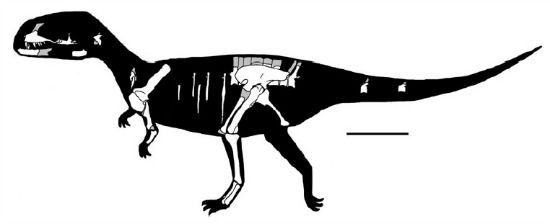Finding Duriavenator
Jaws once thought to be from Megalosaurus belong instead to this little-known species
/https://tf-cmsv2-smithsonianmag-media.s3.amazonaws.com/filer/04/a9/04a92429-3394-44a0-9fb7-11ede6cb1d7e/duriavenator-skull.jpg)
If you have been following the Dinosaur Alphabet series so far, you may have noticed a pattern among the first four entries. At one time or another, all the dinosaurs I’ve selected so far were thought to be different animals. The horned Agujaceratops was originally named as a species of Chasmosaurus, the distinctive high-spines of Becklespinax gave Richard Owen’s dopey Megalosaurus its hump, the sauropod Cetiosaurus was originally envisioned as a giant crocodile, and the armored Dyoplosaurus was lumped in with its cousin Euoplocephalus before being split back out again as a distinct genus. I didn’t intend this trend, but it struck me when I came across one of the rejected candidate for yesterday’s entry for the letter D. Had it not shared much of its story with Becklespinax, I would have picked Duriavenator:
Megalosaurus was a mess. Even though this Jurassic carnivore has been a prehistoric icon ever since it was named by William Buckland in 1824, it has been one of the most confounding of all dinosaurs. That’s because generations of researchers attributed dozens of fragments and isolated bones to the dinosaur, creating a monstrous composite of animals from different places and times. Dinosaurs were unfamiliar animals–the name itself only coined in 1842–and 19th-century naturalists didn’t have the kind of geologic resolution their intellectual descendants rely on to properly constrain when particular species lived. Sometimes researchers named too many species on the basis of scrappy, non-overlapping material, and other times they applied the same name ad infinitum to roughly similar fossils.
Eventually, though, it became apparent that Megalosaurus was unstable. No one could say what the dinosaur really looked like or what bones could accurately be attributed to the predator. The situation was so bad that, in 2008, paleontologist Roger Benson and colleagues stripped the name Megalosaurus from everything save for the fragment of jaw originally used to name the animal. Whether the rest of the fossils really belonged to Megalosaurus remained to be seen, and, as Benson demonstrated later the same year, at least one other theropod had been improperly obscured behind the famous name.
In 1883, anatomist Richard Owen described a partial theropod skull found on Dorset, England, as another piece of Megalosaurus “bucklandi.” The sharp-toothed dinosaur was only represented by parts of the upper and lower jaws, but, given how little was known about Megalosaurus to start with, Owen’s assignment was reasonable. Nearly a century later, paleontologist Michael Waldman proposed that these fossils represented a previously unknown species of the dinosaur he called Megalosaurus hesperis. Other researchers weren’t sure that the bones really belonged to Megalosaurus, but it wasn’t until Benson’s reexamination that the fossils were split out as a different dinosaur. While the dinosaur was a close cousin of Megalosaurus bucklandii, Benson was able to pick out subtle anatomical characteristics that distinguished the fragmentary skull. In Benson’s analysis, what once was Megalosaurus took on a new life as Duriavenator hesperis.

Unfortunately, we don’t know very much at all about Duriavenator. The dinosaur lived about 170 million years ago in Jurassic England and was a large carnivore of comparable size to the 20-foot-plus Megalosaurus, but that’s where the evidence gives out. Perhaps other Duriavenator specimens are resting in museum collections, but until the discovery of a nearly complete skeleton allows paleontologists to connect the jaws to a body, the dinosaur will be an enigma. But here Megalosaurus itself gives us reason to hope. The Duriavenator paper was just part of Benson’s effort to rehabilitate Megalosaurus, and in 2010 he published a refined, revised reconstruction of the dinosaur’s skeleton based on material collected from Stonesfield, Oxfordshire–the locality where the original jaw came from. Perhaps, with a little detective work in the lab and in the field, paleontologists might also be able to fill out the form of Duriavenator and other Middle Jurassic mysteries.
References:
Benson, R., Barrett, P., Powell, H., Norman, D. 2008. The taxonomic status of Megalosaurus bucklandii (Dinosauria, Theropoda) from the Middle Jurassic of Oxfordshire, UK. Palaeontology, 51, 2: 419-424.
Benson, R. 2008. A redescription of “Megalosaurus” hesperis (Dinosauria, Theropoda) from the Inferior Oolite (Bajocian, Middle Jurassic) of Dorset, United Kingdom. Zootaxa 1931: 57-67
Benson, R. 2010. A description of Megalosaurus bucklandii (Dinosauria: Theropoda) from the Bathonian of the UK and the relationships of Middle Jurassic theropods. Zoological Journal of the Linnean Society 158: 882. doi:10.1111/j.1096-3642.2009.00569.x.
Waldman, M. 1974. Megalosaurids from the Bajocian (Middle Jurassic) of Dorset. Palaeontology 17, 2:325-339.
/https://tf-cmsv2-smithsonianmag-media.s3.amazonaws.com/accounts/headshot/RileyBlack.png)
/https://tf-cmsv2-smithsonianmag-media.s3.amazonaws.com/accounts/headshot/RileyBlack.png)